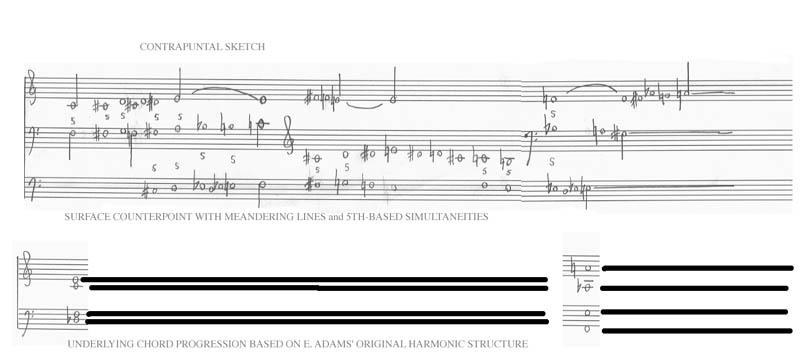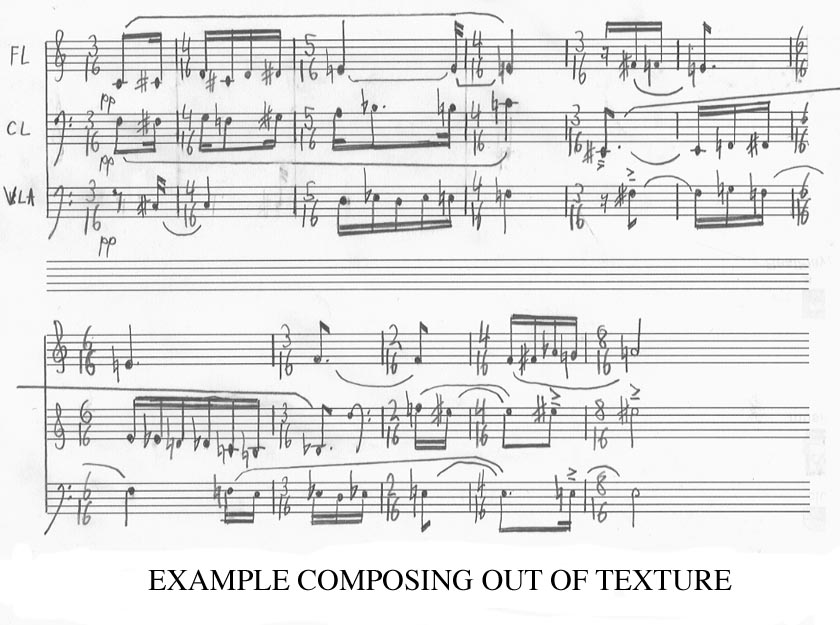or
What to do if you (momentarily) lack "inspiration"
This was developed from comments I made in an undergraduate composition seminar in Spring 2000
(It might take a moment for all of the images to load, so be patient.)
We begin with a bit of harmonic structure fragment, a background voice-leading plan of 4 chords that a student was trying to work with:
E A C Db C Ab A C F E G# G# Db F F E
We'd like to do more than write an atonal chorale. (Though that's not necessarily bad in itself.) How do we make this rather plain "background" into an interesting "foreground"?
Fist, let us consult the dictionary randomly:
panhandle
salt
letters testamentary
china
Platte
hundredfold
major
capillary
launch
We now free-associate to get musical ideas. Some words suggest textures, others suggest so-called "parameters", others, ????:
panhandle ----> Handel -----> how "French overture" are the rhythms?
salt ------> SA -----> Eb - A ------> these two notes form a drone against a line.
letters testamentary ------> saying who controls a will -------> death ------> 5th -----> when
to double with a 5th
china ------> dishes --------> how clangy are the articulations?
Platte -----> river in Nebraska ---------> meandering chromatic line
hundredfold -----------> present a motive. then present it "multiplied" many times.
major ------> the only simultaneities are major triads.
capillary ----------> capillary action in plants ------> gradually "clusterize" chords from
top to bottom
launch ---------> that annoying Mannheim rocket motive that Classical symphonies often begin with.
Now we will come up with some "duets" "between" the above concepts. (All duets will actually form, in the end, a "trio" with the E Adams-style harmonic structure)
(I choose these randomly)
letters
Platte
salt
panhandle
china
capillary
major
hundredfold
What do I mean by "duet"? Well, somehow these ideas are counterpointed against one another.
As an exercise, before you go on, think about each duet, how would you compose
music combining these ideas with the Elizabeth's harmonic structure? Free associate briefly on the
composing process. Then, you can check out the example of this that I came up with. Scroll down.
Here, then, is one fragment of an example "solution" to the "problem" posed by the first of the suggested "duets." This "duet" is between "letters testamentary" and "Platte". Through free association, I come to the idea of a "meandering chromatic line" plus "doubling at the 5th". Thinking about this for a while---we could have lines chromatically meandering from one chord tone (that is --- a tone of one of the chords from the Adamsian chord progression) to another. thus:
example 2---a typical line, perhaps for flute:

example 3---another typical line, perhaps for clarinet, (untransposed):

example 4--- and a third, perhaps a viola line (in bass clef for your reading pleasure):

"Letters testamentary" led us to the idea of the 5th doubling. So, let's try linking up these lines where there are 5ths. We're just exploring, here, where the lines might or might not join together:
example 5--- connections between the three lines

Now after examining the possible relationships between these, we can write the stuff out neatly (well . . . ok, I have horrible handwriting) in a contrapuntal sketch. The rule is, if you're ("you" being a contrapuntal line) not participating in a stacked 5th sonority, then jump back to a tone of the current background-voice-leading-structure chord.
example 6---counterpoint network (I'm writing in easy-to-read clefs, and with no transposing instrument business, for now):

This "thing" that we have come up with, even if you compose it out in the simplest fashion, rhythmically, will still be interesting, because it "contains" a lot of rhythmic information in it already. I.e.---there are places where some voices stop, and other voices continue; there are little quasi-neighbor-note formations (neighbor-notes automatically give you some kind of rhythmic hierarchy, since one note is "more important" than another), and speaking of hierarchies, well, the notes of the original chords could be held longer, and are "more important" in any case, thus suggesting kinds of accent----these accents could be in counterpoint to other accents that you compose out on the musical "surface."
This is what I've meant when I've spoken about composing interesting rhythm "into" the structure itself---as opposed to trying to make an interesting rhythm, at the last moment, for a structure that is a mere succession of events.
Thus even if we simply compose out with, rhythmically speaking, simple sequences of 8ths and 16ths, the result can still be somewhat musically compelling:

I might make some improvements to this little fragment---probably notational, perhaps simplifying the meter changes so performers don't freak; maybe I'd add some other instruments to emphasize the meter at certain points, etc. etc.; also, the flute part is low, which will work at a dynamic of pp, but if everyone starts getting loud, it's gonna be swallowed up. There may be other issues as well.
But, hopefully I've made my point.